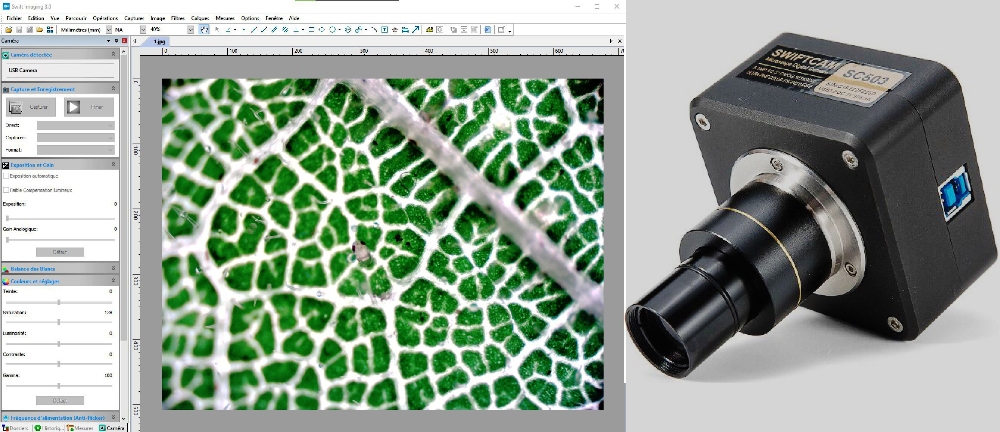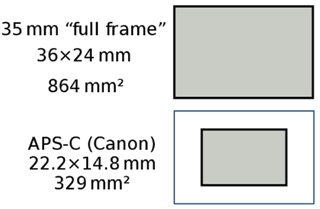 No need to consider photographing springtails without a minimum of equipment. It is necessary to have at least a 1: 1 ratio macro lens, that is to say that the size of the subject photographed after passing through the optical system (objective) will be the same on the sensor. The sensor "APSC" of a device like the one I use (Canon EOS 7D mkII) measures 22.2 mm x 14.8 mm. (opposite right, in full size). The APSC sensor has the advantage of allowing a slightly larger depth of field with identical aperture and a magnification ratio of about 1.6 compared to a "FF" (full frame - 24 mm x 32 mm) sensor, like that of my EOS 6D MKII). The negative side is the appearance of chromatic aberration when closing the diaphragm too much, and also a loss of dynamics in low light, however this last problem can be partly solved with the use of a flash.
No need to consider photographing springtails without a minimum of equipment. It is necessary to have at least a 1: 1 ratio macro lens, that is to say that the size of the subject photographed after passing through the optical system (objective) will be the same on the sensor. The sensor "APSC" of a device like the one I use (Canon EOS 7D mkII) measures 22.2 mm x 14.8 mm. (opposite right, in full size). The APSC sensor has the advantage of allowing a slightly larger depth of field with identical aperture and a magnification ratio of about 1.6 compared to a "FF" (full frame - 24 mm x 32 mm) sensor, like that of my EOS 6D MKII). The negative side is the appearance of chromatic aberration when closing the diaphragm too much, and also a loss of dynamics in low light, however this last problem can be partly solved with the use of a flash.
The choice of editing will depend on many factors such as the size of the subject, the ambient light, the use, or not, of a flash. In the case of springtails the magnification ratio is paramount, so the use of an objective dedicated to macro photography (from the ratio 1: 1) will not be sufficient to obtain satisfactory results. It will provide accessories that can increase this ratio. The extended rings, the zoom multiplier or the windscreens will make it possible. But beware each of these accessories acts on different parameters.
- Extended rings, by moving the lens away from the sensor, can reduce the minimum focusing distance and therefore closer to the subject, if the minimum focusing distance of your lens is 31.2 cm (105 Sigma Macro) ) the use of 68 mm of elongated ring will allow you to get closer so that the resulting ratio will be 1.56: 1 (formula g = (f + b / f) -1) with a focus distance of 27.6 mm. On the other hand, the loss of luminosity with these rings elongated is quite important and will require compromises unless using a TTL flash.
- The use of a zoom multiplier (I use a 1.4 X) allows to obtain a macro lens with a focal length of 147 mm (from 105 mm Sigma) allowing a direct focus, infinity to the ratio 1.4 / 1.
- The windscreens that screw in front of the lens act as magnifying glasses and allow to get closer to the subject without loss of light. On the other hand, the quality of the image deteriorates very quickly if we attach several windscreens. There are different types, that having only one lens and those called achromatic associating two lenses. It is obvious that the second, rather expensive, allow to obtain better results. I use a windshield of +3 (2 + 1) diopter associated with my 105 mm, which gives a resultant focal length of 178 mm.
These accessories can be mounted simultaneously with various assembly solutions. The calculations become more complex and it is the experience that takes over here his rights ...
Below are three examples of magnification ratios showing the size a springtail will have on an APS-C sensor (the proportions of the size of the digital sensor and the springtails are respected). From then on we understand the interest of having important magnification ratios.

A counterpart, and not least, should be taken into account, especially since the magnification ratios used will be important: The depth of field is the range of distances determining the sharpness area of ??an image, its value depends directly from the focal length and magnification ratio. The table below gives an idea of ??the narrowness of this range when we increase the magnification ratio.
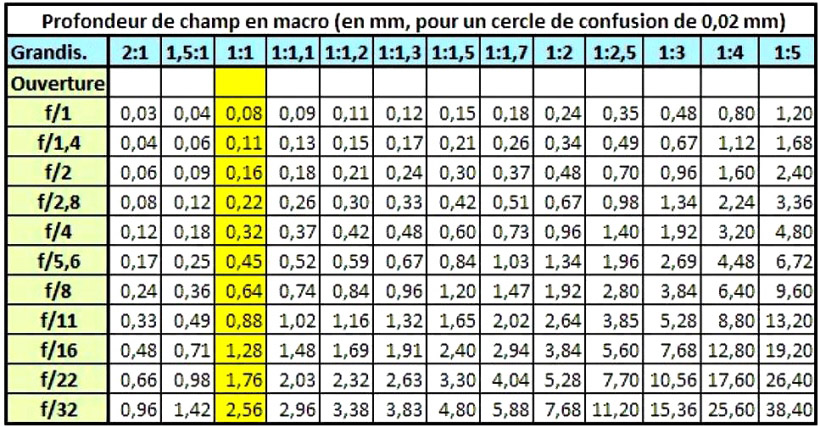
For example 105 mm macro only = (ratio 1: 1), with aperture of f / 16 (the one I use with an annular flash), the depth of field will be 1.28 mm. in other words if the object I photograph is more than 1.28 mm all parties outside this range will be blurry!
But things get tough with for example the Canon MP-E 65 mm f 2.8 1-5 x Macro lens:
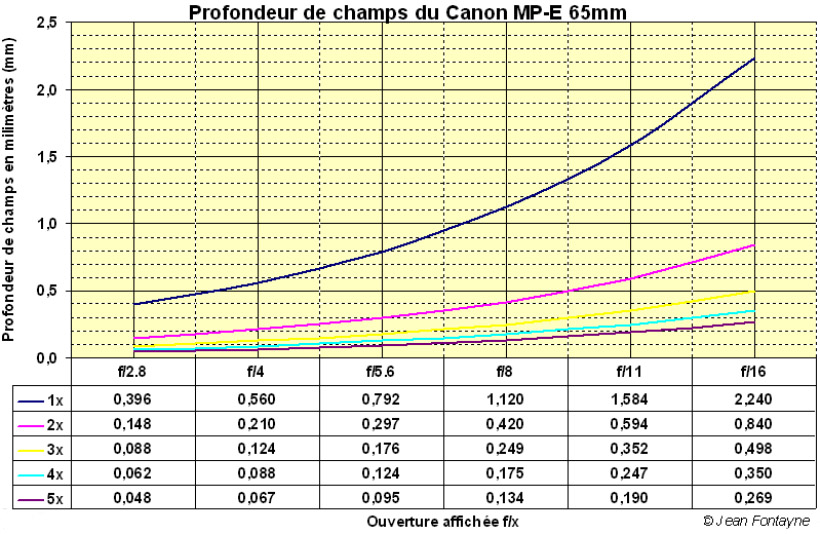
For example with an f / 11 aperture and magnification ratio of 3: 1 the depth of field is 0.352 mm. Which means that taking the photograph does not have any margin of movement, as much as it is imperative to "stall" the camera firmly. beyond 1: 1 to 2: 1 we can forget the freehand photography. It should also be understood that any subject whose size will be greater than 0.352 mm will record areas of blur. It is still necessary that the central point of this beach is precisely on the point where one wishes to have a good sharpness (eye for example)
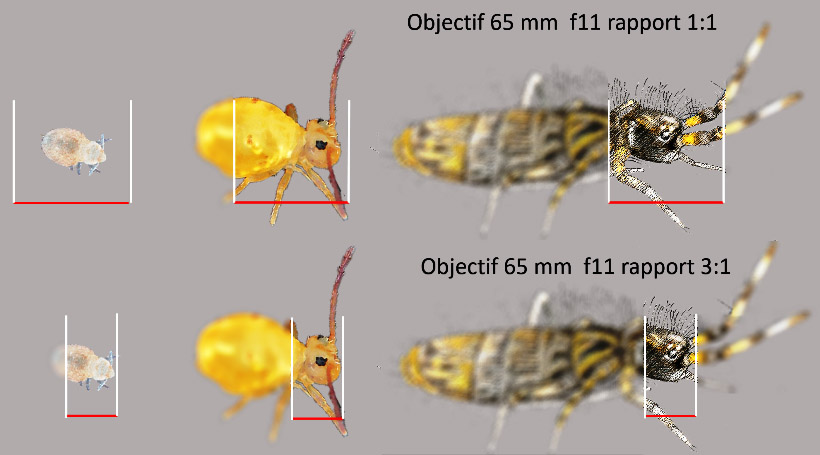
If I take the example of the three springtails with two different settings of the lens, here are the areas of sharpness that result ...
I started photographing springtails with a 1: 1 ratio to familiarize myself with this particular photographic work and then, gradually, I increased the ratios, until I added 3 rings to my lens (see image below) . Since the experience came, I was able to switch to ratios of 3: 1 (with the Canon MP-E65 mm). As for the ratios 4: 1 and 5: 1, I still record a significant percentage (between 50 and 70%) of waste, fortunately the digital allows nowadays what would be unthinkable or too expensive with the film photography.
Finally, in the field I use occasional LED lighting that allows in some cases to create less dark backgrounds or shooting without flash when I want wider shots. (See image at the bottom of page)
- Canon EOS7D MkII + grip (battery life) + 3 extended Kenko rings (68 mm) + Sigma lens 105 mm 1: 2,8

- EOS 6D MKII : Reflex "Full Frame - 24x36 mm"

With this case and using an optical assembly identical to that used with the EOS 7D MKII, the magnification (x1.7) relative to the APS-C sensor of the latter is lost.
However, the number of additional pixels (26.2 million - 6 million more than the EOS 7D MKII) allows for better cropping. The Full Frame sensor, due to the larger size of its photosites also offers the possibility to "go up" to ISO with a lower loss of quality.
This case is a good complement, especially for larger field images.
- My objectives according to the subjects: Tamron 90 mm AF 1: 2.8 DI / Sigma 105 mm 1: 2.8 DG macro HSM / Canon MP-E 65 mm f2.8 1-5 x Macro Photo.
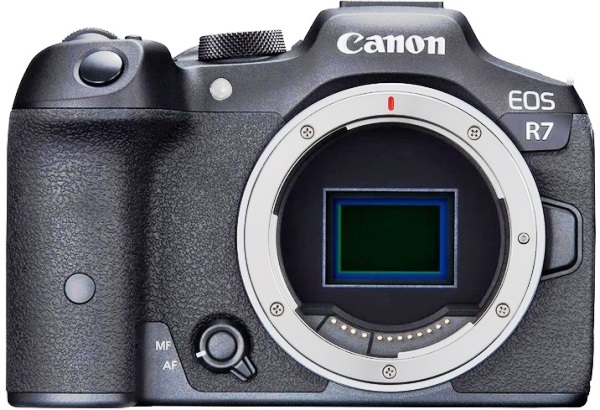 The latest generation of hybrid cameras from Canon makes it possible to advantageously replace the old reflex cameras of the D7 family (APSC). The R7 has a 32.5 million pixel sensor which provides more details on the subjects photographed. Sensitivity in low light situations is improved and can, if necessary, perform bursts of 15 frames per second. Just as efficient in photography as in video, I was able to test it in macro with the MP65 and the results are rather positive. The only downside for my use is that the aiming is carried out by a digital screen which requires a time of adaptation before being able to achieve very fine focusing. On the other hand, the R7 offers focusing assistance which compensates for this little problem by indicating the perfect point. On macro lenses equipped with autofocus, the map is very fast and you can even use an AI that recognizes subjects and detects their movements. Stabilization of the lens is no longer necessary because here, it is the sensor which is stabilized. The box also has integrated wifi and a GPS system which allows easy management and transfer of images. To use this body with my lenses, simply purchase a Canon EF-EOS R adapter ring.
The latest generation of hybrid cameras from Canon makes it possible to advantageously replace the old reflex cameras of the D7 family (APSC). The R7 has a 32.5 million pixel sensor which provides more details on the subjects photographed. Sensitivity in low light situations is improved and can, if necessary, perform bursts of 15 frames per second. Just as efficient in photography as in video, I was able to test it in macro with the MP65 and the results are rather positive. The only downside for my use is that the aiming is carried out by a digital screen which requires a time of adaptation before being able to achieve very fine focusing. On the other hand, the R7 offers focusing assistance which compensates for this little problem by indicating the perfect point. On macro lenses equipped with autofocus, the map is very fast and you can even use an AI that recognizes subjects and detects their movements. Stabilization of the lens is no longer necessary because here, it is the sensor which is stabilized. The box also has integrated wifi and a GPS system which allows easy management and transfer of images. To use this body with my lenses, simply purchase a Canon EF-EOS R adapter ring.
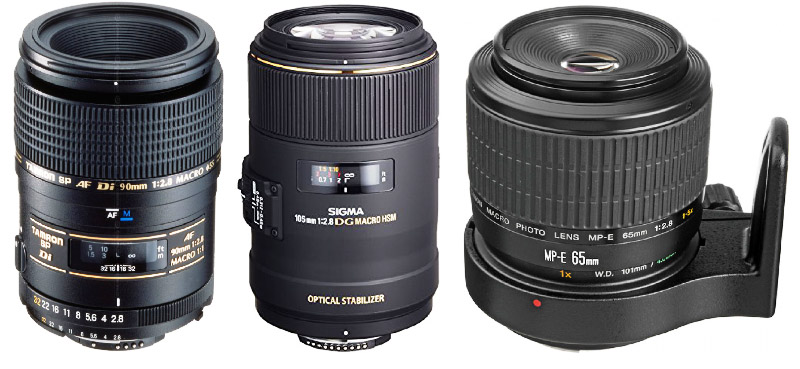
- Multiplier x 1.4 (AF 1.4 x teleplus pro 300) - Bonnet + 1 / + 2 / + 4 diopters.

- Canon MR-14 EXII Canon / Canon Speedlite 430 EX II (as slave) / Sigma EM 140 DG annular ring flash.

- "Cold" light source. (For microphotography or video, cold light is less color-altering than halogen lighting).
- Rollei Tripod. Very light aluminum with a ball joint that allows wide movements.
- 96 LED lamp (600 lux) "Star Cluster" Kaiser, mounted on mini ball-point. Battery powered LP-E6 (canon) or AA NiMh batteries or AA batteries.

- Brinch Advance ICD trinocular magnifier (magnification from x 10 to x 160 with Barlow Lens x 2).
- Trinocular microscope AmScope T490 (magnification from x20 to x2000).
- Preparation tools.

5MP high speed USB3.0 digital camera, with acquisition software (Swift imaging 3.0) allowing live capture of photographs and video films from the computer control screen. The camera is equipped with a CMOS color sensor. Format 1 / 2.5 (5.70mm x 4.28mm, 7.13mm diagonal). 2.2μm x 2.2μm pixels. 1.76v / lux-sec (550nm).
